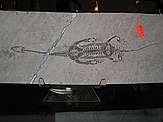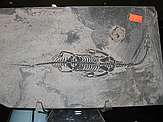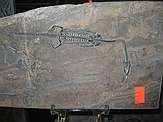![Giant ground sloth\nGlossotherium chapadmalense\nLate Pliocene (2 mya)\nJefferson County, Florida\n[retrieved from river]](img_1886_thm.jpg)
Giant ground sloth
Glossotherium chapadmalense
Late Pliocene (2 mya)
Jefferson County, Florida
[retrieved from river]
|

Keichousaurus, China
Triassic Aquatic Reptile
(Reptilia, Pachypleurosauria)
Keichousaurus was an early reptile that lived during the Triassic Period (roughly 245 - 208 Ma). The animals were small, about 15-30 cm (6-12 inches) long, with a long neck and tail, five-toed feet with long digits, and a pointed head with sharp teeth.
They may have lived in the water though they had sturdy legs. Fossils have been found in Guizhou Province, China, and are popular with collectors, principally because complete articulated skeletons are relatively common from this area.
Systematics
Phylum Chordata
Subphylum Vertebrata
Class Reptilia
Subclass Sauropterygia
The Sauropterygia were marine predators of the Mesozoic. This taxon includes the Triassic near shore orders, Nothosauria and Pachypleurosauria, and the post-Triassic, fully marine, Plesiosauria (which comprises the short-necked pliosaurs and the longer-necked plesiosaurs, read more).
Order Pachypleurosauria
The Pachypleurosaurs were small, lightly built lizard-like reptiles, generally less than a meter, the smallest being about 20 cm. They were clearly related to the contemporary Nothosaurs (order Nothosauria). For a long time the Pachypleurosaurs were included with the Nothosaurs, and originally even placed under the same family Nothosauridae.
Description: Small to medium (< ~1m) in size. Skull unusually small; jaws not elongated; pterygoids expanded to completely cover brain case ventrally; upper fenestra smaller than large orbit; strong upper bar; no lower fenestra; post-orbital skull short; quadrate embayed and slender stapes (impedence-matching ear for airborne vibrations and thus amphibious?); long (18 cervicals) neck; three sacral vertebrae; dorsoventral extension of vertebral spines near base of tail; dorsal verts have low neural spines, thickened and dense (pachyostosis); pachyostosis extends to ribs in more derived species; girdles poorly ossified (thus obligate marine?); limbs not highly derived for aquatic life; restricted to epicontinental & coastal areas.
The neck is long but, unlike the Nothosauria the head is very small (like the eosuchian Claudiosaurus), so pachypleurosaurs probably fed on very small fish and crustacea.
Relatively small dorsal temporal openings in the skull also clearly distinguish the Pachypleurosaurs from the Nothosaurian genera such as Lariosaurus, Ceresiosaurus, Corosaurus, Paranothosaurus and Simosaurus, in all of which the upper temporal openings are much larger than the orbits. The tail is deep and would have been used as a swimming organ.
Habit: The legs were semi-flattened to serve as paddles, but the hips and shoulders were still powerful and functional enough to provide support on land. It is likely that these animals were able to crawl about on land like modern seals, dragging themselves by their strong forelimbs. As with the nothosaurids they were semi-aquatic forms, mostly lagoonal but also venturing out to sea, perhaps not unlike the modern marine iguana in that respect. Their small size meant however they probably did not venture out far, being primarily near-shore forms.
The neck is long but, unlike the Nothosauria the head is very small (like the eosuchian Claudiosaurus), so pachypleurosaurs probably fed on very small fish and crustacea.
Occurrence: Middle Triassic (Anisian-Ladinian) of Europe and China. The Pachypleurosauria appear to have originated in China (Keichousaurus is basal) and migrated to Europe via the northern border of Tethys Sea.
Discussion: The current belief is that Pachypleurosaur line forms part of the bridge between the Sauropterygian stem (e.g. Placodonts) and the Eusauropterygia (e.g. Plesiosaurs). The connection is an admittedly difficult one to make, but the fossil record gives few options. To make this phylogenetic region yet stranger, a prolonged stare at the pachypleurosaurs tends to bring turtles to mind – yet another taxon of still-uncertain affinities. Look, for example, at the way the dorsal and caudal ribs seem to rise up above the level of the sacrum (the fused area of bone at the intersection of the pelvis and the spine) in the many available photographs of Keichousaurus. Turtles are the only group of vertebrates with both sets of limb girdles inside the rib cage. Yet it would take little modification to give this unique character to a pachypleurosaur. The pachyostosis of the ribs, from which the group derived its name, is similar to the broad, heavy ribs of turtles. Although pachypleurosaurs themselves are unarmoured, one group of Placodonts has strikingly turtle-like armour.
This relationship between Sauropterygians and turtles was widely defended at the end of the last century. It seemed to fall apart, on details of skull anatomy among other things. However, the concept has recently been revived by Olivier Rieppel and others. The idea has also gained some support from DNA cladistics which tends to place the turtles up above the Diapsid split, although their placement is sometimes (perhaps embarrassingly) closer to Archosaurs than to Lepidosaurs. However, given the total absence of (other?) living Sauropterygians, a little uncertainty is only to be expected.
Family Pachypleurosauridae Nopcsa 1928
Genus Keichousaurus Young 1958
Type: Keichousaurus hui Young 1958
Description: Keichousaurus shows the elongated skill and long serpentine neck and tail, and general features, of the typical Pachypleurosaur. However the ulna is massive (fig. 1), quite unlike those of any of the European genera.
Occurrence: Middle Triassic of Guizhou Province, China
References
Corroy, M. G. 1928: Les vertebres du Trias de Lorraine et le Trias Lorrain. Annales de Paleontologie, XVII.
Lin, K.; Rieppel, O. 1998: Functional morphology and ontogeny of Keichousaurus hui (Reptilia, Sauropterygia). Fieldiana, Geol. (NS) 39: 1998.
Nopcsa, F. 1928: Palaeontological Notes on Reptiles. Geologica Hungarica, Tomus 1 (Fasc. 1)
Young, C.-C. 1958: On the New Pachypleurosauroidea from Keichow, South-West China. Vertebrata PalAsiatica, 2 (2).
Young, C.-C. 1965: On the New Nothosaurs from Hupeh and Kweichou, China. Vertebrata PalAsiatica, 9 (4).
|

Keichousaurus hui Young 1958
Middle Triassic of Guizhou Province, China
|

Keichousaurus hui Young 1958
Middle Triassic of Guizhou Province, China
|

